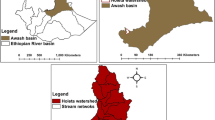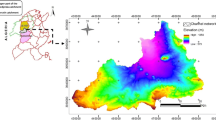Abstract—
The objective of this paper is to test the feasibility of using the SWAT model under limited data availability to estimate soil erosion in two adjacent watersheds, namely Mazer (gauged) and El Himer (ungauged) watersheds. In this study, we used the physical proximity approach as one of the regionalization methods while ensuring the similarity between both watersheds. Moreover, the comparison of the most important characteristics that influence runoff production shows that Mazer and El Himer watersheds are nearly similar in terms of soil, land use and all other morphological and physical characteristics. In aiming to achieve the objectives set out in this study, SWAT Model was calibrated and validated on a monthly time step at Mazer watershed using SWAT-CUP (SUFI-2). Results showed a good correlation between the observed and simulated streamflow with a NSE (Nash–Sutcliffe Efficiency) of 0.65, 0.89 and R2 of 0.75, 0.95 for calibration and validation, respectively. After the calibration and validation processes in Mazer watersheds, the fitted values for the most sensitive parameters have been applied at El Himer watershed and both models were executed for 5 years to estimate streamflow and soil erosion at Mazer and El Himer watershed. The results showed that all studied subwatersheds present a weak amount of soil erosion rate, with a maximum of 5.20 t/ha/year. Generally, soil erosion in El Himer is slightly high. The average annual values recorded of sediment yield at Mazer and El Himer were 725 and 2991 tons/year, respectively. Moreover, the results obtained can be used in other watersheds with the same characteristics. The interest shown in this type of study stems from our major problem inherent in the developing country, where very few measuring stations are available. It is hoped to demonstrate the utility of regionalization and to encourage modelers to work more on ungauged watersheds.









Similar content being viewed by others
REFERENCES
K. C. Abbaspour, SWAT-CUP4: SWAT Calibration and Uncertainty Programs: A User Manual (Swiss Federal Institute of Aquatic Science and Technology, Dübendorf, 2011), p. 106.
K. C. Abbaspour, J. Yang, I. Maximov, R. Siber, K. Bogner, J. Mieleitner, and R. Srinivasan, “Modeling hydrology and water quality in the pre-alpine/alpine Thur watershed using SWAT,” J. Hydrol. 333 (2–4), 413–430 (2007). https://doi.org/10.1016/j.jhydrol.2006.09.014
O. M. M. Abdelwahab, G. F. Ricci, A. M. De Girolamo, and F. Gentile, “Modeling soil erosion in a Mediterranean watershed: comparison between SWAT and AnnAGNPS models,” Environ. Res. 166, 363–376 (2018). https://doi.org/10.1016/j.envres.2018.06.029
J. G. Arnold, D. N. Moriasi, P. W. Gassman, K. C. Abbaspour, M. J. White, R. Srinivasan, and N. Kannan, “SWAT: model use, calibration, and validation,” Trans. ASABE 55 (4), 1491–1508 (2012).
J. G. Arnold, R. Srinivasan, R. S. Muttiah, and J. R. Williams, “Large area hydrologic modeling and assessment. Part I: Model development,” J. Am. Water Resour. Assoc. 34 (1), 73–89. (1998). https://doi.org/10.1111/j.1752-1688.1998.tb05961.x
R. Arsenault and F. P. Brissette, “Continuous streamflow prediction in ungauged basins: The effects of equifinality and parameter set selection on uncertainty in regionalization approaches,” Water Resour. Res. 50 (7), 6135–6153 (2014). https://doi.org/10.1002/2013wr014898
A. Bárdossy, “Calibration of hydrological model parameters for ungauged catchments,” Hydrol. Earth Syst. Sci. 11 (2), 703–710 (2007). https://doi.org/10.5194/hess-11-703-2007
B. C. Bates, Regionalization of Hydrologic Data: A Review (Cooperative Research Centre for Catchment Hydrology, Canberra, 1994).
H. E. Beck, A. I. van Dijk, A. De Roo, D. G. Miralles, T. R. McVicar, J. Schellekens, and L. A. Bruijnzeel, “Global-scale regionalization of hydrologic model parameters,” Water Resour. Res. 52 (5), 3599–3622 (2016).
K. Beven and A. Binley, “The future of distributed models: model calibration and uncertainty prediction,” Hydrol. Process. 6 (3), 279–298 (1992). https://doi.org/10.1002/hyp.3360060305
J. Blaszczynski, “Estimating watershed runoff and sediment yield using a GIS interface to curve number and MUSLE models,” in Bureau of Land Management Resource Notes No. 66 (US Department of Interior, Washington, DC, 2003).
G. Blöschl, “Rainfall-runoff modeling of ungauged catchments,” in Encyclopedia of Hydrological Sciences (Wiley, New York, 2006). https://doi.org/10.1002/0470848944.hsa140
G. Blöschl and M. Sivapalan, “Scale issues in hydrological modeling: a review,” Hydrol. Process. 9 (3–4), 251–290 (1995). https://doi.org/10.1002/hyp.3360090305
Y. Bouslihim, A. Rochdi, N. E. A. Paaza, and L. Liuzzo, “Understanding the effects of soil data quality on SWAT model performance and hydrological processes in Tamedroust watershed (Morocco),” J. Afr. Earth Sci. 160, 103616 (2019). https://doi.org/10.1016/j.jafrearsci.2019.103616
H. Briak, R. Moussadek, K. Aboumaria, and R. Mrabet, “Assessing sediment yield in Kalaya gauged watershed (Northern Morocco) using GIS and SWAT model,” Int. Soil Water Conserv. Res. 4 (3), 177–185 (2016). https://doi.org/10.1016/j.iswcr.2016.08.002
A. Bronstert, D. Niehoff, and G. Bürger, “Effects of climate and land-use change on storm runoff generation: present knowledge and modeling capabilities,” Hydrol. Process. 16 (2), 509–529 (2002). https://doi.org/10.1002/hyp.326
R. Eberhart and J. Kennedy, “A new optimizer using particle swarm theory,” in Proceedings of the Sixth International Symposium on Micro Machine and Human Science, MHS’95 (Institute of Electrical and Electronics Engineers, Piscataway, NJ, 1995), pp. 39–43. https://doi.org/10.1109/mhs.1995.494215
D. R. Fuka, M. T. Walter, C. Macalister, A. T. Degaetano, T. S. Steenhuis, and Z. M. Easton, “Using the Climate Forecast System Reanalysis as weather input data for watershed models,” Hydrol. Process. 28 (22), 5613–5623 (2014). https://doi.org/10.1002/hyp.10073
H. El Gasmi, B. El Mansouri, and M. Tammal, “Surface flows in the plate of Settat-Ben Ahmed and the plain of Berrechid: endoreic hydrography,” Int. J. Innovation Sci. Res. 9, 40–53 (2014).
W. H. Green and G. A. Ampt, “Studies on soil physics,” J. Agric. Sci. 4 (1), 1–24 (1911). https://doi.org/10.1017/s0021859600001441
A. V. Griensven and W. Bauwens, “Multiobjective autocalibration for semidistributed water quality models,” Water Resour. Res. 39 (12), (2003). https://doi.org/10.1029/2003wr002284
H. V. Gupta, S. Sorooshian, and P. O. Yapo, “Toward improved calibration of hydrologic models: multiple and noncommensurable measures of information,” Water Resour. Res. 34 (4), 751–763 (1998). https://doi.org/10.1029/97wr03495
Y. He, A. Bárdossy, and E. Zehe, “A review of regionalisation for continuous streamflow simulation,” Hydrol. Earth Syst. Sci. 15 (11), 3539–3553 (2011). https://doi.org/10.5194/hess-15-3539-2011
M. Hrachowitz, H. Savenije, G. Blöschl, J. Mcdonnell, M. Sivapalan, J. Pomeroy, and C. Cudennec, “A decade of predictions in ungauged basins (PUB)—a review,” Hydrol. Sci. J. 58 (6), 1198–1255 (2013).https://doi.org/10.1080/02626667.2013.80318325
K. Kaffas, V. Hrissanthou, and S. Sevastas, “Modeling hydromorphological processes in a mountainous basin using a composite mathematical model and ArcSWAT,” Catena 162, 108–129 (2018). https://doi.org/10.1016/j.catena.2017.11.017
P. Krause, D. P. Boyle, and F. Bäse, “Comparison of different efficiency criteria for hydrological model assessment,” Adv. Geosci. 5, 89–97 (2005). https://doi.org/10.5194/adgeo-5-89-2005
G. Kuczera and E. Parent, “Monte Carlo assessment of parameter uncertainty in conceptual catchment models: the Metropolis algorithm,” J. Hydrol. 211 (1–4), 69–85 (1998). https://doi.org/10.1016/s0022-1694(98)00198-x
L. Ma, J. C. A. Ii, L. R. Ahuja, M. J. Shaffer, J. D. Hanson, and K. W. Rojas, “Root Zone Water Quality Model sensitivity analysis using Monte Carlo simulation,” Trans. ASAE 43 (4), 883–895 (2000). https://doi.org/10.13031/2013.2984
B. Merz and A. Bárdossy, “Effects of spatial variability on the rainfall runoff process in a small loess catchment,” J. Hydrol. 212–213, 304–317 (1998). https://doi.org/10.1016/s0022-1694(98)00213-3
R. Merz and G. Blöschl, “Regionalization of catchment model parameters,” J. Hydrol. 287 (1–4), 95–123 (2004). https://doi.org/10.1016/j.jhydrol.2003.09.028
R. Merz, G. Blöschl, and J. D. Parajka, “Regionalization methods in rainfall-runoff modelling using large catchment samples,” in Large Sample Basin Experiments for Hydrological Model Parameterization: Results of the Model Parameter Experiment–MOPEX (International Association of Hydrological Sciences, Wallingford, 2006).
D. N. Moriasi, J. G. Arnold, M. W. V. Liew, R. L. Bingner, R. D. Harmel, and T. L. Veith, “Model evaluation guidelines for systematic quantification of accuracy in watershed simulations,” Trans. ASABE 50 (3), 885–900 (2007). https://doi.org/10.13031/2013.23153
J. Nash and J. Sutcliffe, “River flow forecasting through conceptual models: Part I—A discussion of principles,” J. Hydrol. 10 (3), 282–290 (1970). https://doi.org/10.1016/0022-1694(70)90255-6
S. L. Neitsch, J. G. Arnold, J. R. Kiniry, and J. R. Williams, Soil and Water Assessment Tool Theoretical Documentation, Version 2009 (Texas A&M Natural Resources Institute, College Station, TX, 2011),
L. Oudin, V. Andréassian, C. Perrin, C. Michel, and N. L. Moine, “Spatial proximity, physical similarity, regression and ungaged catchments: A comparison of regionalization approaches based on 913 French catchments,” Water Resour. Res. 44 (3), (2008). https://doi.org/10.1029/2007wr006240
I. Ouraich and W. E. Tyner, Climate Change Impacts on Moroccan Agriculture and the Whole Economy. An Analysis of the Impacts of the Plan Maroc Vert in Morocco: WIDER Working Paper 83/2014 (United Nations University World Institute for Development Economics Research, Helsinki, 2014) https://doi.org/10.35188/unu-wider/2014/804-9
J. Parajka, A. Viglione, M. Rogger, J. L. Salinas, M. Sivapalan, and G. Blöschl, “Comparative assessment of predictions in ungauged basins—Part 1: Runoff-hydrograph studies,” Hydrol. Earth Syst. Sci. 17 (5), 1783–1795 (2013). https://doi.org/10.5194/hess-17-1783-2013
T. Razavi and P. Coulibaly, “Streamflow prediction in ungauged basins: review of regionalization methods,” J. Hydrol. Eng. 18 (8), 958–975 (2013). https://doi.org/10.1061/(asce)he.1943-5584.0000690
M. Requier-Desjardins, Impacts des Changements Climatiques sur l’Agriculture au Maroc et en Tunisie et Priorités d’Adaptation (Centre International de Hautes Études Agronomiques Méditerranéennes, Montpellier, 2010).
J. Samuel, P. Coulibaly, and R. A. Metcalfe, “Estimation of continuous streamflow in Ontario ungauged basins: Comparison of regionalization methods,” J. Hydrol. Eng. 16 (5), 447–459 (2011). https://doi.org/10.1061/(asce)he.1943-5584.0000338
G. Sapriza-Azuri, J. Jódar, V. Navarro, L. J. Slooten, J. Carrera, and H. V. Gupta, “Impacts of rainfall spatial variability on hydrogeological response,” Water Resour. Res. 51 (2), 1300–1314 (2015). https://doi.org/10.1002/2014wr016168
K. E. Saxton and W. J. Rawls, “Soil water characteristic estimates by texture and organic matter for hydrologic solutions,” Soil Sci. Soc. Am. J. 70 (5), 1569–1578 (2006). https://doi.org/10.2136/sssaj2005.0117
Soil Conservation Service, “Hydrology,” in National Engineering Handbook (United States Department of Agriculture, Beltsville, MD, 1972), Section 4.
X. Song, J. Zhang, C. Zhan, Y. Xuan, M. Ye, and C. Xu, “Global sensitivity analysis in hydrological modeling: review of concepts, methods, theoretical framework, and applications,” J. Hydrol. 523, 739–757 (2015).
A. Stehr, P. Debels, F. Romero, and H. Alcayaga, “Hydrological modelling with SWAT under conditions of limited data availability: evaluation of results from a Chilean case study,” Hydrol. Sci. J. 53 (3), 588–601 (2008). https://doi.org/10.1623/hysj.53.3.588
X. Wang and A. M. Melesse, “Effects of STATSGO and SSURGO as inputs on SWAT model’s snowmelt simulation,” J. Am. Water Resour. Assoc. 42 (5), 1217–1236 (2006). https://doi.org/10.1111/j.1752-1688.2006.tb05296.x
J. R. Williams, “Sediment routing for agricultural watersheds 1,” J. Am. Water Resour. Assoc. 11 (5), 965–974 (1975).
A. W. Worqlul, E. K. Ayana, H. Yen, J. Jeong, C. Macalister, R. Taylor, et al., “Evaluating hydrologic responses to soil characteristics using SWAT model in a paired-watersheds in the Upper Blue Nile Basin,” Catena 163, 332–341 (2018). https://doi.org/10.1016/j.catena.2017.12.040
H. Wu and B. Chen, “Evaluating uncertainty estimates in distributed hydrological modeling for the Wenjing River watershed in China by GLUE, SUFI-2, and ParaSol methods,” Ecol. Eng. 76, 110–121 (2015). https://doi.org/10.1016/j.ecoleng.2014.05.014
A. Yair and N. Raz-Yassif, “Hydrological processes in a small arid catchment: scale effects of rainfall and slope length,” Geomorphology 61 (1–2), 155–169 (2004). https://doi.org/10.1016/j.geomorph.2003.12.003
A. R. Young, “Stream flow simulation within UK ungauged catchments using a daily rainfall-runoff model,” J. Hydrol. 320 (1–2), 155–172. (2006). https://doi.org/10.1016/j.jhydrol.2005.07.017
Author information
Authors and Affiliations
Corresponding author
Ethics declarations
The authors declare that they have no conflict of interest.
Rights and permissions
About this article
Cite this article
Bouslihim, Y., Rochdi, A. & Paaza, N.E. Combining SWAT Model and Regionalization Approach to Estimate Soil Erosion under Limited Data Availability Conditions. Eurasian Soil Sc. 53, 1280–1292 (2020). https://doi.org/10.1134/S1064229320090021
Received:
Revised:
Accepted:
Published:
Issue Date:
DOI: https://doi.org/10.1134/S1064229320090021




